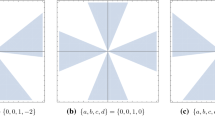Abstract
The Weyl—Wigner prescription for quantization on Euclidean phase spaces makes essential use of Fourier duality. The extension of this property to more general phase spaces requires the use of Kac algebras, which provide the necessary background for the implementation of Fourier duality on general locally compact groups. Kac algebras—and the duality they incorporate—are consequently examined as candidates for a general quantization framework extending the usual formalism. Using as a test case the simplest nontrivial phase space, the halfplane, it is shown how the structures present in the complete-plane case must be modified. Traces, for example, must be replaced by their noncommutative generalizations—weights—and the correspondence embodied in the Weyl—Wigner formalism is no longer complete. Provided the underlying algebraic structure is suitably adapted to each case, Fourier duality is shown to be indeed a very powerful guide to the quantization of general physical systems.
Similar content being viewed by others
References
Aldrovandi, R., and Galetti, D. (1990). On the structure of quantum phase space,Journal of Mathematical Physics,31(12), 2987–2995.
Aldrovandi, R., and Saeger, L. A. (1996). Projective Fourier duality and Weyl quantization, to appear inInternat. J. Theor. Phys.
Arnold, V. I. (1978).Mathematical Methods of Classical Mechanics, Springer-Verlag, Berlin.
Barut, A. O., and Raczka, R. (1977).Theory of Group Representations and Applications, Polish Scientific Publishers, Warsaw.
Bayen, F., Flato, M., Fronsdal, C., Lichnerowicz, A. and Sternheimer, D. (1978). Deformation theory and quantization, I and II,Annals of Physics,111, 61–110, 111–151.
Bratteli, O., and Robinson, D. W. (1987).Operator Algebras and Quantum Statistical Mechanics 1, 2nd ed., Springer, New York.
Dixmier, J. (1977).C *-Algebras, North-Holland, Amsterdam.
Enock, M., and Schwartz, J.-M. (1973).Comptes Rendus de l'Academie des Sciences Paris,277A, 683–685.
Enock, M., and Schwartz, J.-M. (1974a). Une dualité deans les algèbres de von Neumann,Bulletin de la Société Mathématique de France (Mémoire),44, 1–144.
Enock, M., and Schwartz, J.-M. (1974b).Comptes Rendus de l'Academie des Sciences Paris,279A, 643–645.
Enock, M., and Schwartz, J.-M. (1992).Kac Algebras and Duality of Locally Compact Groups, Springer, Berlin.
Folland, G. B. (1989).Harmonic Analysis in Phase Space, Princeton University Press, Princeton, New Jersey.
Gurarie, D. (1992).Symmetries and Laplacians, North-Holland, Amsterdam.
Hillery, M., O'Connel, R. F., Scully, M. O., and Wigner, E. P. (1984). Distribution functions in physics: Fundamentals.Physics Reports,106, 121–167.
Isham, C. J. (1984). Topological and Global aspects of quantum theory, inRelativity, Groups and Topology II, B. S. DeWitt and R. Stora, eds., North-Holland, Amsterdam.
Kac, G. I., and Vaînermann, L. I. (1974a). Nonunimodular ring-groups and Hopf-von Neumann algebras.Soviet Mathematics-Doklady,14, 1144–1148.
Kac, G. I., and Vaînermann, L. I. (1974b).Mathematics of the USSR-Sbornik,23, 185–214.
Kadison, R. V., and Ringrose, J. R. (1986).Fundamentals of the Theory of Operator Algebras, Academic Press, Boston.
Kirillov, A. A. (1976).Elements of the Theory of Representations, Springer-Verlag, Berlin.
Landsman, N. P. (1993). Deformations of algebras of observables and the classical limit of quantum mechanics,Reviews in Mathematical Physics,5(4), 775–806.
Lee, H.-W. (1995). Theory and application of the quantum phase-space distribution functions,Physics Reports,259, 147–211.
Mackey, G. W. (1957). Borel structure in groups and their duals,Transactions of the American Mathematical Society,85, 134–165.
Mackey, G. W. (1958). Unitary representations of group extensions, I.Acta Mathematica,99, 265–311.
Mackey, G. W. (1978).Unitary Group Representations in Physics, Probability and Number Theory, Benjamin/Cummings, Reading, Massachusetts.
Moyal, J. E. (1949). Quantum mechanics as a statistical theory.Proceedings of the Cambridge Philosophical Society,45, 99–124.
Reiter, H. (1968).Classical Harmonic Analysis and Locally Compact Groups, Oxford University Press, Oxford.
Sugiura, M. (1990).Unitary Representations and Harmonic Analysis, North-Holland/Kodansha, Amsterdam.
Takesaki, M. (1971). Duality and von Neumann algebras,Bulletin of the American Mathematical Society,77(4), 553–557.
Takesaki, M. (1972).Lecture Notes in Mathematics, Vol. 247, Springer, Berlin, pp. 665–785.
Taylor, M. E. (1986).Noncommutative Harmonic Analysis, American Mathematical Society, Providence, Rhode Island.
Vaînermann, L. I. (1974). Characterization of objects dual to locally compact groups,Functional Analysis and Its Applications,8, 66–67.
Vaînermann, L. I. (1988). Duality of algebras with an involution and generalized shift operators,Journal of Soviet Mathematics,42(6), 2113–2138.
Varadarajan, V. S. (1970).Geometry of Quantum Theory, van Nostrand Reinhold, New York, Vol. II.
Weyl, H. (1931).The Theory of Groups and Quantum Mechanics, Dover, New York.
Wigner, E. P. (1932). On the quantum correction for thermodynamic equilibrium,Physical Review,40, 749–759.
Woronowicz, S. L. (1987). Compact matrix pseudogroups,Communications in Mathematical Physics,111, 613–665.
Author information
Authors and Affiliations
Rights and permissions
About this article
Cite this article
Aldrovandi, R., Saeger, L.A. Fourier duality as a quantization principle. Int J Theor Phys 36, 345–383 (1997). https://doi.org/10.1007/BF02435738
Received:
Issue Date:
DOI: https://doi.org/10.1007/BF02435738




